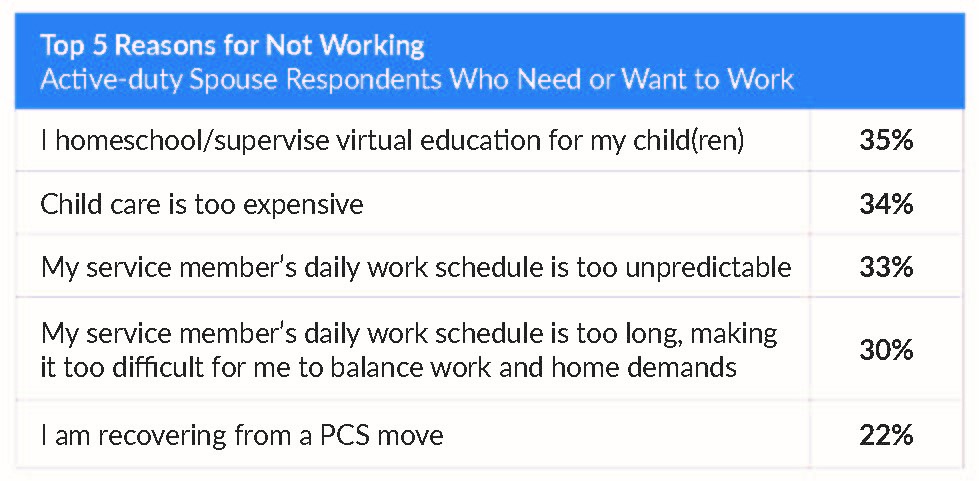
Unemployment and underemployment have always been a top concern for U.S. military spouses and in 2020 those concerns only grew stronger.
“The issues that we were already facing as military families were intensified by COVID-19,” says Jessica Strong, co-director of applied research for Blue Star Families, a nonprofit founded to help military spouses and children thrive as their loved ones serve the country.
“We already were dealing with barriers to spouse employment and spouse underemployment. We already were dealing with maintaining stable children’s education and high-quality children’s education. We already were dealing with time away. ”

Blue Star Families recently released the findings of its annual Military Family Lifestyle Survey in partnership with the Institute for Veterans & Military Families (IVMF) at Syracuse University.
Strong calls the survey a “snapshot understanding of what issues military families are dealing with, what are the most important issues, and what are some solutions that we can use to address those issues.”
Blue Star and IVMF say it serves as a blueprint for enhancing military family life.
“It’s very comprehensive. It’s about employment. It’s about deployment. It’s about PCS (permanent change of station). It’s about housing. It’s about financial stability. It’s about education. It’s about mental health. We cover a number of different topics and that is absolutely unique,” explains Rosalinda V. Maury, director of applied research for IVMF.
Military Spouses and Employment
Spouse employment topped the list of issues for active-duty families in the latest survey, with good reason. The evidence is in the numbers.
“Out of all the subgroups that we looked at—National Guard, Reserve, veterans, spouses of veterans, and active-duty service members—I think military spouses are probably the most affected when it comes to employment,” says Strong.
The survey finds that 42% of spouses who were working before COVID stopped at some point during the pandemic, primarily due to furloughs or layoffs.
Strong says a number of spouses who continued working or returned to jobs were working less. “When we fielded the 2020 survey in September and October, 30% had reduced their hours at work because of COVID.”
Overall, findings indicate that 20% of active-duty spouses were unemployed at the time the survey was conducted.
She notes, “When we talk about active-duty spouses, the vast majority are female.”
Barriers to Spouse Employment
“I want to call out that unemployment rates for military spouses have always been relatively three, four times higher than their veteran counterparts,” says Maury.

Relocation creates an employment barrier for spouses. “The mobility of the military lifestyle is absolutely a critical factor. Especially as you move place-to-place, you might have to find a new job,” Maury says. “Certainly, you don’t start at the top. You always start at the bottom. So, you can’t even build a career from that point.”
Strong adds, “When you end military service at 20 years, you’re not on the same playing field as somebody who has been working in their career field for 20 years. You will never catch up.”
“The unemployment issues that face veterans are different from the unemployment issues that military spouses face,” continues Strong. “Veterans are less likely to have childcare needs. They may be less likely to have to balance their work experience with their spouse’s work experience.”

Solutions to Military Spouse Unemployment
“Now is the time to really move the needle for military spouse unemployment. Really tackling it,” stresses Maury.
She adds, “Remote work offer solutions for military spouses. It really has potential for military spouses to ultimately tackle the huge unemployment challenge that they have. So, it could be the silver lining in all of this.”
“I think employers should be looking into really providing not just temporary, but permanent remote portable solutions so that they can continue to retain their employees.”
Strong, being a military spouse, says of an upcoming permanent change of station, “This is the first time in 15 years, I will not have to leave a job because it’s remote.”
The Entrepreneurship Pathway
“I think entrepreneurship is a viable option because for those that are unable to do traditional employment, they can create their own work hours. You can create your own schedule. You can work wherever you want,” says Maury.
“You can take it overseas. There are some challenges with that. No doubt. But entrepreneurship is a viable option because ultimately you do control a lot of it. It’s not easy. I won’t say that, but there are training programs.”
IVMF offers eight national, no-cost entrepreneurial training programs depending on where a business is in its growth cycle.
STEM-related Training
IVMF also offers trainings through its Onward to Opportunity program. “We provide IT certification training, and it is free to military spouses. We go for the in-demand STEM career because that does offer the flexibility for portability and the remote working environment,” explains Maury.
Blue Star Families also offers tech learning opportunities. Says Strong, “We have a careers program that connects military families with tech training, job search prep, and employers who are looking to hire military spouses.”
Racial and Gender Equity
After a year that forced issues of equity into the spotlight, the survey finds most respondents who experienced racial or gender discrimination did not report the incidents. “Nearly one in 10 veterans of color reported racial discrimination was one of the reasons they left military service.”
Additionally, “Fewer than half of service members reported feeling a sense of belonging to their unit. The number was even lower for female service members.”
Strong notes, “We also saw that there is the perception of discrimination by race, by gender in the military. And that’s obviously an issue that’s been important for employers across the board for a long time now. In the military, there’s been this narrative that ‘Everybody is green. Everybody’s equal. Everybody’s evaluated on the same things. We don’t see color.’ We may not see color, but that doesn’t mean that the outcomes are equitable.”
“When we talk about sense of belonging to the unit or the command, those service members of color feel less of a sense of belonging to the unit or command. That’s important because feeling a sense of belonging to the place that you work has mental health outcomes and impacts. That has productivity and employment outcomes and impacts,” says Strong.
The findings indicate, “The spouse unemployment rate is higher in active-duty spouse respondents of color (27% vs. 17%).”
“I think this is a general trend when you look at labor stats that sometimes the unemployment rates for families of color is higher, generally,” notes Maury.
“We’re doing further work into really understanding military families of colors. We’re doing a needs assessment. Doing a deep dive. More analysis, more research so that we really do understand the diversity of experiences so that we can provide more support,” says Maury.

Blue Star Families in collaboration with Syracuse University’s IVMF has already begun work on the 2021 survey. If you are military-related and would like to participate, click here.











